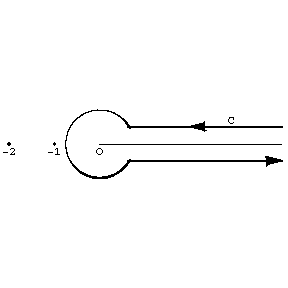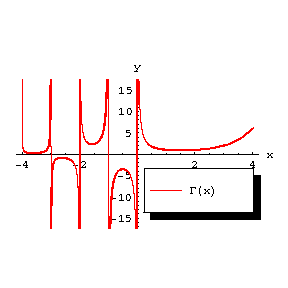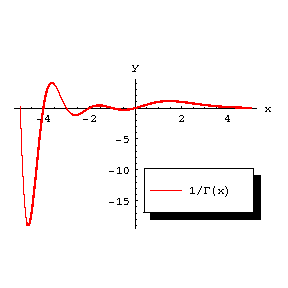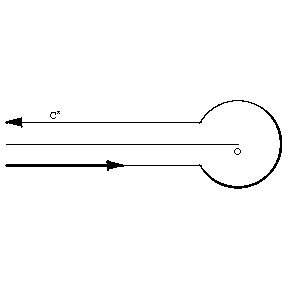Difference between revisions of "Gamma-function"
(Importing text file) |
(copied from discussion) |
||
| Line 1: | Line 1: | ||
| − | '' | + | ''$\Gamma$-function'' |
| − | + | {{MSC|33B15|33B20,33D05}} | |
| + | {{TEX|done}} | ||
| + | $ | ||
| + | \newcommand{\abs}[1]{\left|#1\right|} | ||
| + | \newcommand{\Re}{\mathop{\mathrm{Re}}} | ||
| + | \newcommand{\Im}{\mathop{\mathrm{Im}}} | ||
| + | $ | ||
| − | + | A transcendental function $\Gamma(z)$ that extends the values of the factorial $z!$ to any complex number $z$. It was introduced in 1729 by L. Euler in a letter to Ch. Goldbach, using the infinite product | |
| + | $$ | ||
| + | \Gamma(z) = | ||
| + | \lim_{n\rightarrow\infty}\frac{n!n^z}{z(z+1)\ldots(z+n)} = | ||
| + | \lim_{n\rightarrow\infty}\frac{n^z}{z(1+z/2)\ldots(1+z/n)}, | ||
| + | $$ | ||
| + | which was used by L. Euler to obtain the integral representation (Euler integral of the second kind, cf. [[Euler integrals]]) | ||
| + | $$ | ||
| + | \Gamma(z) = \int_0^\infty x^{z-1}e^{-x} \rd x, | ||
| + | $$ | ||
| + | which is valid for $\Re z > 0$. The multi-valuedness of the function $x^{z-1}$ is eliminated by the formula $x^{z-1}=e^{(z-1)\ln x}$ with a real $\ln x$. The symbol $\Gamma(z)$ and the name gamma-function were proposed in 1814 by A.M. Legendre. | ||
| − | < | + | If $\Re z < 0$ and $-k-1 < \Re z < -k$, $k=0,1,\ldots$, the gamma-function may be represented by the Cauchy–Saalschütz integral: |
| − | + | $$ | |
| − | + | \Gamma(z) = \int_0^\infty x^{z-1} | |
| − | + | \left( | |
| − | + | e^{-x} - \sum_{m=0}^k (-1)^m \frac{x^m}{m!} | |
| − | + | \right) \rd x. | |
| − | + | $$ | |
| − | + | In the entire plane punctured at the points $z=0,-1,\ldots $, the gamma-function satisfies a Hankel integral representation: | |
| − | + | $$ | |
| − | + | \Gamma(z) = \frac{1}{e^{2\pi iz} - 1} \int_C s^{z-1}e^{-s} \rd s, | |
| − | + | $$ | |
| − | + | where $s^{z-1} = e^{(z-1)\ln s}$ and $\ln s$ is the branch of the logarithm for which $0 < \arg\ln s < 2\pi$; the contour $C$ is represented in Fig. a. [FIXME] It is seen from the Hankel representation that $\Gamma(z)$ is a [[Meromorphic function|meromorphic function]]. At the points $z_n = -n$, $n=0,1,\ldots$ it has simple poles with residues $(-1)^n/n!$. | |
| − | In the entire plane punctured at the points | ||
| − | |||
| − | |||
| − | |||
| − | where | ||
<img style="border:1px solid;" src="https://www.encyclopediaofmath.org/legacyimages/common_img/g043310a.gif" /> | <img style="border:1px solid;" src="https://www.encyclopediaofmath.org/legacyimages/common_img/g043310a.gif" /> | ||
| Line 28: | Line 39: | ||
==Fundamental relations and properties of the gamma-function.== | ==Fundamental relations and properties of the gamma-function.== | ||
| − | |||
1) Euler's functional equation: | 1) Euler's functional equation: | ||
| − | + | $$ | |
| − | + | z\Gamma(z) = \Gamma(z+1), | |
| − | + | $$ | |
or | or | ||
| − | + | $$ | |
| − | + | \Gamma(z) = \frac{1}{z\ldots(z+n)}\Gamma(z+n+1); | |
| − | + | $$ | |
| − | + | $\Gamma(1)=1$, $\Gamma(n+1) = n!$ if $n$ is an integer; it is assumed that $0! = \Gamma(1) = 1$. | |
2) Euler's completion formula: | 2) Euler's completion formula: | ||
| − | + | $$ | |
| − | + | \Gamma(z)\Gamma(1-z) = \frac{\pi}{\sin \pi z}. | |
| − | + | $$ | |
| − | In particular, | + | In particular, $\Gamma(1/2)=\sqrt{\pi}$; |
| − | + | $$ | |
| − | + | \Gamma\left(n+\frac{1}{2}\right) = | |
| − | + | \frac{1.3\ldots(2n-1)}{2^n}\sqrt{\pi} | |
| − | if | + | $$ |
| − | + | if $n>0$ is an integer; | |
| − | + | $$ | |
| + | \abs{\Gamma\left(\frac{1}{2} + iy\right)}^2 = | ||
| + | \frac{\pi}{\cosh y\pi}, | ||
| + | $$ | ||
| + | where $y$ is real. | ||
3) Gauss' multiplication formula: | 3) Gauss' multiplication formula: | ||
| + | $$ | ||
| + | \prod_{k=0}^{m-1} \Gamma\left( z + \frac{k}{m} \right) = | ||
| + | (2\pi)^{(m-1)/2}m^{(1/2)-mz}\Gamma(mz), \quad m = 2,3,\ldots | ||
| + | $$ | ||
| + | If $m=2$, this is the Legendre duplication formula. | ||
| − | + | 4) If $\Re z \geq \delta > 0$ or $\abs{\Im z} \geq \delta > 0$, then $\ln\Gamma(z)$ can be asymptotically expanded into the Stirling series: | |
| − | + | $$ | |
| − | + | \ln\Gamma(z) | |
| − | + | = \left(z-\frac{1}{2}\right)\ln z | |
| − | 4) If | + | - z |
| − | + | + \frac{1}{2}\ln 2\pi | |
| − | + | + \sum_{n=1}^m \frac{B_{2n}}{2n(2n-1)z^{2n-1}} | |
| − | + | + O\bigl(z^{-2m-1}\bigr), \quad m = 1,2,\ldots, | |
| − | + | $$ | |
| − | + | where $B_{2n}$ are the [[Bernoulli numbers]]. It implies the equality | |
| − | where | + | $$ |
| − | + | \Gamma(z) = \sqrt{2\pi} z^{z-1/2} z^{-z} | |
| − | + | \left( | |
| − | + | 1 | |
| − | + | + \frac{1}{12}z^{-1} | |
| − | + | + \frac{1}{288}z^{-2} | |
| + | - \frac{139}{51840}z^{-3} | ||
| + | - \frac{571}{2488320}z^{-4} | ||
| + | + O\bigl(z^{-5}\bigr) | ||
| + | \right). | ||
| + | $$ | ||
In particular, | In particular, | ||
| + | $$ | ||
| + | \Gamma(1+x) = \sqrt{2\pi} x^{x+1/2} e^{-x + \theta/12x}, | ||
| + | \quad 0 < \theta < 1. | ||
| + | $$ | ||
| + | More accurate is Sonin's formula {{Cite|So}}: | ||
| + | $$ | ||
| + | \Gamma(1+x) = \sqrt{2\pi} x^{x+1/2} e^{-x + 1/12(x+\theta)}, | ||
| + | \quad 0 < \theta < 1/2. | ||
| + | $$ | ||
| − | + | 5) In the real domain, $\Gamma(x) > 0$ for $x > 0$ and it assumes the sign $(-1)^{k+1}$ on the segments $-k-1 < x < -k$, $k = 0,1,\ldots$ (Fig. b). | |
| − | |||
| − | |||
| − | |||
| − | |||
| − | |||
| − | 5) In the real domain, | ||
<img style="border:1px solid;" src="https://www.encyclopediaofmath.org/legacyimages/common_img/g043310b.gif" /> | <img style="border:1px solid;" src="https://www.encyclopediaofmath.org/legacyimages/common_img/g043310b.gif" /> | ||
| Line 84: | Line 111: | ||
Figure: g043310b | Figure: g043310b | ||
| − | The graph of the function | + | The graph of the function $ $. |
| − | |||
| − | |||
| − | + | For all real $x$ the inequality | |
| + | $$ | ||
| + | \Gamma\Gamma^{\prime\prime} > \bigl(\Gamma^\prime\bigr)^2 \geq 0 | ||
| + | $$ | ||
| + | is valid, i.e. all branches of both $\abs{\Gamma(x)}$ and $\ln\abs{\Gamma(x)}$ are convex functions. The property of logarithmic convexity defines the gamma-function among all solutions of the functional equation | ||
| + | $$ | ||
| + | \Gamma(1+x) = x\Gamma(x) | ||
| + | $$ | ||
| + | up to a constant factor (see also the | ||
| + | [[Bohr-Mollerup theorem|Bohr–Mollerup theorem]]). | ||
| − | + | For positive values of $x$ the gamma-function has a unique minimum at $x=1.4616321\ldots$ equal to $0.885603\ldots$. The local minima of the function $\abs{\Gamma(x)}$ form a sequence tending to zero as $x\rightarrow -\infty$. | |
| − | |||
| − | |||
| − | |||
| − | |||
| − | |||
| − | For positive values of | ||
<img style="border:1px solid;" src="https://www.encyclopediaofmath.org/legacyimages/common_img/g043310c.gif" /> | <img style="border:1px solid;" src="https://www.encyclopediaofmath.org/legacyimages/common_img/g043310c.gif" /> | ||
| Line 102: | Line 130: | ||
Figure: g043310c | Figure: g043310c | ||
| − | The graph of the function | + | The graph of the function $ $. |
| − | |||
| − | |||
| − | |||
| − | |||
| − | |||
| − | |||
| − | + | 6) In the complex domain, if $\Re z > 0$, the gamma-function rapidly decreases as $\abs{\Im z} \rightarrow \infty$, | |
| + | $$ | ||
| + | \lim_{\abs{\Im z} \rightarrow \infty} | ||
| + | \abs{\Gamma(z)}\abs{\Im z}^{(1/2)-\Re z}e^{\pi\abs{\Im z}/2} = | ||
| + | \sqrt{2\pi}. | ||
| + | $$ | ||
| + | 7) The function $1/\Gamma(z)$ (Fig. c) is an entire function of order one and of maximal type; asymptotically, as $r \rightarrow \infty$, | ||
| + | $$ | ||
| + | \ln M(r) \sim r \ln r, | ||
| + | $$ | ||
where | where | ||
| − | + | $$ | |
| − | + | M(r) = \max_{\abs{z} = r} \frac{1}{\abs{\Gamma(z)}}. | |
| − | + | $$ | |
It can be represented by the infinite Weierstrass product: | It can be represented by the infinite Weierstrass product: | ||
| − | + | $$ | |
| − | + | \frac{1}{\Gamma(z)} = z e^{\gamma z} \prod_{n=1}^\infty | |
| − | + | \left(\left( 1 + \frac{z}{n} \right) e^{-z/n} \right), | |
| − | which converges absolutely and uniformly on any compact set in the complex plane ( | + | $$ |
| − | + | which converges absolutely and uniformly on any compact set in the complex plane ($\gamma$ is the [[Euler constant]]). A Hankel integral representation is valid: | |
| − | + | $$ | |
| − | + | \frac{1}{\Gamma(z)} = \frac{1}{2\pi i} \int_{C'} e^s s^{-z} \rd s, | |
| − | where the contour | + | $$ |
| + | where the contour $C'$ is shown in Fig. d. | ||
<img style="border:1px solid;" src="https://www.encyclopediaofmath.org/legacyimages/common_img/g043310d.gif" /> | <img style="border:1px solid;" src="https://www.encyclopediaofmath.org/legacyimages/common_img/g043310d.gif" /> | ||
| Line 130: | Line 162: | ||
Figure: g043310d | Figure: g043310d | ||
| − | + | $ $ | |
| − | |||
| − | |||
| − | |||
| − | |||
| − | + | G.F. Voronoi {{Cite|Vo}} obtained integral representations for powers of the gamma-function. | |
| − | |||
| − | |||
| − | |||
| − | |||
| − | |||
| − | |||
| − | |||
| − | |||
| − | |||
| − | |||
| + | In applications, the so-called poly gamma-functions — $k$th derivatives of $\ln\Gamma(z)$ — are of importance. The function (Gauss' $\psi$-function) | ||
| + | $$ | ||
| + | \psi(z) = | ||
| + | \frac{\mathrm{d}}{\mathrm{d}z}\ln\Gamma(z) = | ||
| + | \frac{\Gamma'(z)}{\Gamma(z)} = | ||
| + | -\gamma + \sum_{n=0}^\infty \frac{z-1}{(n+1)(z+n)} = | ||
| + | -\gamma + \int_0^1 \frac{1 - (1-t)^{z-1}}{t} \rd t | ||
| + | $$ | ||
| + | is meromorphic, has simple poles at the points $z=0,-1,\ldots$ and satisfies the functional equation | ||
| + | $$ | ||
| + | \psi(z+1) - \psi(z) = \frac{1}{z}. | ||
| + | $$ | ||
| + | The representation of $\psi(z)$ for $\abs{z}<1$ yields the formula | ||
| + | $$ | ||
| + | \ln\Gamma(1+z) = | ||
| + | -\gamma z + \sum_{k=2}^\infty \frac{(-1)^k S_k}{k} z^k, | ||
| + | $$ | ||
where | where | ||
| + | $$ | ||
| + | S_k = \sum_{n=1}^\infty n^{-k}. | ||
| + | $$ | ||
| + | This formula may be used to compute $\Gamma(z)$ in a neighbourhood of the point $z=1$. | ||
| − | + | For other poly gamma-functions see {{Cite|BaEr}}. The [[Incomplete gamma-function|incomplete gamma-function]] is defined by the equation | |
| − | + | $$ | |
| − | + | I(x,y) = \int_0^y e^{-t}t^{x-1} \rd t. | |
| − | + | $$ | |
| − | For other poly gamma-functions see | + | The functions $\Gamma(z)$ and $\psi(z)$ are transcendental functions which do not satisfy any linear differential equation with rational coefficients (Hölder's theorem). |
| − | |||
| − | |||
| − | |||
| − | The functions | ||
| − | |||
| − | |||
| − | + | The exceptional importance of the gamma-function in mathematical analysis is due to the fact that it can be used to express a large number of definite integrals, infinite products and sums of series (see, for example, [[Beta-function]]). In addition, it is widely used in the theory of special functions (the [[Hypergeometric function|hypergeometric function]], of which the gamma-function is a limit case, [[Cylinder functions|cylinder functions]], etc.), in analytic number theory, etc. | |
| − | |||
| + | ====References==== | ||
| + | {| | ||
| + | |- | ||
| + | |valign="top"|{{Ref|An}}||valign="top"| A. Angot, "Compléments de mathématiques. A l'usage des ingénieurs de l'electrotechnique et des télécommunications", C.N.E.T. (1957) | ||
| + | |- | ||
| + | |valign="top"|{{Ref|BaEr}}||valign="top"| H. Bateman (ed.) A. Erdélyi (ed.), ''Higher transcendental functions'', '''1. The gamma function. The hypergeometric functions. Legendre functions''', McGraw-Hill (1953) | ||
| + | |- | ||
| + | |valign="top"|{{Ref|Bo}}||valign="top"| N. Bourbaki, "Elements of mathematics. Functions of a real variable", Addison-Wesley (1976) (Translated from French) | ||
| + | |- | ||
| + | |valign="top"|{{Ref|JaEm}}||valign="top"| E. Jahnke, F. Emde, "Tables of functions with formulae and curves", Dover, reprint (1945) (Translated from German) | ||
| + | |- | ||
| + | |valign="top"|{{Ref|Ni}}||valign="top"| N. Nielsen, "Handbuch der Theorie der Gammafunktion", Chelsea, reprint (1965) | ||
| + | |- | ||
| + | |valign="top"|{{Ref|So}}||valign="top"| N.Ya. Sonin, "Studies on cylinder functions and special polynomials", Moscow (1954) (In Russian) | ||
| + | |- | ||
| + | |valign="top"|{{Ref|Vo}}||valign="top"| G.F. Voronoi, "Studies of primitive parallelotopes", ''Collected works'', '''2''', Kiev (1952) pp. 239–368 (In Russian) | ||
| + | |- | ||
| + | |valign="top"|{{Ref|WhWa}}||valign="top"| E.T. Whittaker, G.N. Watson, "A course of modern analysis", Cambridge Univ. Press (1952) | ||
| + | |- | ||
| + | |} | ||
| − | ====Comments==== | + | ====Comments==== |
| − | |||
| − | + | For an approach to the gamma-function based on the [[Bohr-Mollerup theorem|Bohr–Mollerup]] characterization, see the short monograph by E. Artin {{Cite|Ar}}. | |
| − | + | The $q$-analogue of the gamma-function is given by | |
| + | $$ | ||
| + | \Gamma_q(z) = (1-q)^{1-z} | ||
| + | \prod_{k=1}^\infty \frac{1-q^{k+1}}{1-q^{k+z}}, \quad | ||
| + | z \neq 0,-1,-2,\ldots;\quad 0<q<1, | ||
| + | $$ | ||
| + | cf. {{Cite|As}}. Its origin goes back to E. Heine (1847) and D. Jackson (1904). | ||
| − | + | ====References==== | |
| − | + | {| | |
| − | + | |- | |
| + | |valign="top"|{{Ref|Ar}}||valign="top"| E. Artin, "The gamma function", Holt, Rinehart & Winston (1964) | ||
| + | |- | ||
| + | |valign="top"|{{Ref|As}}||valign="top"| R. Askey, "The $q$-Gamma and $q$-Beta functions" ''Appl. Anal.'', '''8''' (1978) pp. 125–141 | ||
| + | |- | ||
| + | |} | ||
Revision as of 17:51, 27 April 2012
$\Gamma$-function
2020 Mathematics Subject Classification: Primary: 33B15 Secondary: 33B2033D05 [MSN][ZBL] $ \newcommand{\abs}[1]{\left|#1\right|} \newcommand{\Re}{\mathop{\mathrm{Re}}} \newcommand{\Im}{\mathop{\mathrm{Im}}} $
A transcendental function $\Gamma(z)$ that extends the values of the factorial $z!$ to any complex number $z$. It was introduced in 1729 by L. Euler in a letter to Ch. Goldbach, using the infinite product $$ \Gamma(z) = \lim_{n\rightarrow\infty}\frac{n!n^z}{z(z+1)\ldots(z+n)} = \lim_{n\rightarrow\infty}\frac{n^z}{z(1+z/2)\ldots(1+z/n)}, $$ which was used by L. Euler to obtain the integral representation (Euler integral of the second kind, cf. Euler integrals) $$ \Gamma(z) = \int_0^\infty x^{z-1}e^{-x} \rd x, $$ which is valid for $\Re z > 0$. The multi-valuedness of the function $x^{z-1}$ is eliminated by the formula $x^{z-1}=e^{(z-1)\ln x}$ with a real $\ln x$. The symbol $\Gamma(z)$ and the name gamma-function were proposed in 1814 by A.M. Legendre.
If $\Re z < 0$ and $-k-1 < \Re z < -k$, $k=0,1,\ldots$, the gamma-function may be represented by the Cauchy–Saalschütz integral: $$ \Gamma(z) = \int_0^\infty x^{z-1} \left( e^{-x} - \sum_{m=0}^k (-1)^m \frac{x^m}{m!} \right) \rd x. $$ In the entire plane punctured at the points $z=0,-1,\ldots $, the gamma-function satisfies a Hankel integral representation: $$ \Gamma(z) = \frac{1}{e^{2\pi iz} - 1} \int_C s^{z-1}e^{-s} \rd s, $$ where $s^{z-1} = e^{(z-1)\ln s}$ and $\ln s$ is the branch of the logarithm for which $0 < \arg\ln s < 2\pi$; the contour $C$ is represented in Fig. a. [FIXME] It is seen from the Hankel representation that $\Gamma(z)$ is a meromorphic function. At the points $z_n = -n$, $n=0,1,\ldots$ it has simple poles with residues $(-1)^n/n!$.

Figure: g043310a
Fundamental relations and properties of the gamma-function.
1) Euler's functional equation: $$ z\Gamma(z) = \Gamma(z+1), $$ or $$ \Gamma(z) = \frac{1}{z\ldots(z+n)}\Gamma(z+n+1); $$ $\Gamma(1)=1$, $\Gamma(n+1) = n!$ if $n$ is an integer; it is assumed that $0! = \Gamma(1) = 1$.
2) Euler's completion formula: $$ \Gamma(z)\Gamma(1-z) = \frac{\pi}{\sin \pi z}. $$ In particular, $\Gamma(1/2)=\sqrt{\pi}$; $$ \Gamma\left(n+\frac{1}{2}\right) = \frac{1.3\ldots(2n-1)}{2^n}\sqrt{\pi} $$ if $n>0$ is an integer; $$ \abs{\Gamma\left(\frac{1}{2} + iy\right)}^2 = \frac{\pi}{\cosh y\pi}, $$ where $y$ is real.
3) Gauss' multiplication formula: $$ \prod_{k=0}^{m-1} \Gamma\left( z + \frac{k}{m} \right) = (2\pi)^{(m-1)/2}m^{(1/2)-mz}\Gamma(mz), \quad m = 2,3,\ldots $$ If $m=2$, this is the Legendre duplication formula.
4) If $\Re z \geq \delta > 0$ or $\abs{\Im z} \geq \delta > 0$, then $\ln\Gamma(z)$ can be asymptotically expanded into the Stirling series: $$ \ln\Gamma(z) = \left(z-\frac{1}{2}\right)\ln z - z + \frac{1}{2}\ln 2\pi + \sum_{n=1}^m \frac{B_{2n}}{2n(2n-1)z^{2n-1}} + O\bigl(z^{-2m-1}\bigr), \quad m = 1,2,\ldots, $$ where $B_{2n}$ are the Bernoulli numbers. It implies the equality $$ \Gamma(z) = \sqrt{2\pi} z^{z-1/2} z^{-z} \left( 1 + \frac{1}{12}z^{-1} + \frac{1}{288}z^{-2} - \frac{139}{51840}z^{-3} - \frac{571}{2488320}z^{-4} + O\bigl(z^{-5}\bigr) \right). $$ In particular, $$ \Gamma(1+x) = \sqrt{2\pi} x^{x+1/2} e^{-x + \theta/12x}, \quad 0 < \theta < 1. $$ More accurate is Sonin's formula [So]: $$ \Gamma(1+x) = \sqrt{2\pi} x^{x+1/2} e^{-x + 1/12(x+\theta)}, \quad 0 < \theta < 1/2. $$
5) In the real domain, $\Gamma(x) > 0$ for $x > 0$ and it assumes the sign $(-1)^{k+1}$ on the segments $-k-1 < x < -k$, $k = 0,1,\ldots$ (Fig. b).

Figure: g043310b
The graph of the function $ $.
For all real $x$ the inequality $$ \Gamma\Gamma^{\prime\prime} > \bigl(\Gamma^\prime\bigr)^2 \geq 0 $$ is valid, i.e. all branches of both $\abs{\Gamma(x)}$ and $\ln\abs{\Gamma(x)}$ are convex functions. The property of logarithmic convexity defines the gamma-function among all solutions of the functional equation $$ \Gamma(1+x) = x\Gamma(x) $$ up to a constant factor (see also the Bohr–Mollerup theorem).
For positive values of $x$ the gamma-function has a unique minimum at $x=1.4616321\ldots$ equal to $0.885603\ldots$. The local minima of the function $\abs{\Gamma(x)}$ form a sequence tending to zero as $x\rightarrow -\infty$.

Figure: g043310c
The graph of the function $ $.
6) In the complex domain, if $\Re z > 0$, the gamma-function rapidly decreases as $\abs{\Im z} \rightarrow \infty$, $$ \lim_{\abs{\Im z} \rightarrow \infty} \abs{\Gamma(z)}\abs{\Im z}^{(1/2)-\Re z}e^{\pi\abs{\Im z}/2} = \sqrt{2\pi}. $$
7) The function $1/\Gamma(z)$ (Fig. c) is an entire function of order one and of maximal type; asymptotically, as $r \rightarrow \infty$, $$ \ln M(r) \sim r \ln r, $$ where $$ M(r) = \max_{\abs{z} = r} \frac{1}{\abs{\Gamma(z)}}. $$ It can be represented by the infinite Weierstrass product: $$ \frac{1}{\Gamma(z)} = z e^{\gamma z} \prod_{n=1}^\infty \left(\left( 1 + \frac{z}{n} \right) e^{-z/n} \right), $$ which converges absolutely and uniformly on any compact set in the complex plane ($\gamma$ is the Euler constant). A Hankel integral representation is valid: $$ \frac{1}{\Gamma(z)} = \frac{1}{2\pi i} \int_{C'} e^s s^{-z} \rd s, $$ where the contour $C'$ is shown in Fig. d.

Figure: g043310d
$ $
G.F. Voronoi [Vo] obtained integral representations for powers of the gamma-function.
In applications, the so-called poly gamma-functions — $k$th derivatives of $\ln\Gamma(z)$ — are of importance. The function (Gauss' $\psi$-function) $$ \psi(z) = \frac{\mathrm{d}}{\mathrm{d}z}\ln\Gamma(z) = \frac{\Gamma'(z)}{\Gamma(z)} = -\gamma + \sum_{n=0}^\infty \frac{z-1}{(n+1)(z+n)} = -\gamma + \int_0^1 \frac{1 - (1-t)^{z-1}}{t} \rd t $$ is meromorphic, has simple poles at the points $z=0,-1,\ldots$ and satisfies the functional equation $$ \psi(z+1) - \psi(z) = \frac{1}{z}. $$ The representation of $\psi(z)$ for $\abs{z}<1$ yields the formula $$ \ln\Gamma(1+z) = -\gamma z + \sum_{k=2}^\infty \frac{(-1)^k S_k}{k} z^k, $$ where $$ S_k = \sum_{n=1}^\infty n^{-k}. $$ This formula may be used to compute $\Gamma(z)$ in a neighbourhood of the point $z=1$.
For other poly gamma-functions see [BaEr]. The incomplete gamma-function is defined by the equation $$ I(x,y) = \int_0^y e^{-t}t^{x-1} \rd t. $$ The functions $\Gamma(z)$ and $\psi(z)$ are transcendental functions which do not satisfy any linear differential equation with rational coefficients (Hölder's theorem).
The exceptional importance of the gamma-function in mathematical analysis is due to the fact that it can be used to express a large number of definite integrals, infinite products and sums of series (see, for example, Beta-function). In addition, it is widely used in the theory of special functions (the hypergeometric function, of which the gamma-function is a limit case, cylinder functions, etc.), in analytic number theory, etc.
References
| [An] | A. Angot, "Compléments de mathématiques. A l'usage des ingénieurs de l'electrotechnique et des télécommunications", C.N.E.T. (1957) |
| [BaEr] | H. Bateman (ed.) A. Erdélyi (ed.), Higher transcendental functions, 1. The gamma function. The hypergeometric functions. Legendre functions, McGraw-Hill (1953) |
| [Bo] | N. Bourbaki, "Elements of mathematics. Functions of a real variable", Addison-Wesley (1976) (Translated from French) |
| [JaEm] | E. Jahnke, F. Emde, "Tables of functions with formulae and curves", Dover, reprint (1945) (Translated from German) |
| [Ni] | N. Nielsen, "Handbuch der Theorie der Gammafunktion", Chelsea, reprint (1965) |
| [So] | N.Ya. Sonin, "Studies on cylinder functions and special polynomials", Moscow (1954) (In Russian) |
| [Vo] | G.F. Voronoi, "Studies of primitive parallelotopes", Collected works, 2, Kiev (1952) pp. 239–368 (In Russian) |
| [WhWa] | E.T. Whittaker, G.N. Watson, "A course of modern analysis", Cambridge Univ. Press (1952) |
Comments
For an approach to the gamma-function based on the Bohr–Mollerup characterization, see the short monograph by E. Artin [Ar].
The $q$-analogue of the gamma-function is given by $$ \Gamma_q(z) = (1-q)^{1-z} \prod_{k=1}^\infty \frac{1-q^{k+1}}{1-q^{k+z}}, \quad z \neq 0,-1,-2,\ldots;\quad 0<q<1, $$ cf. [As]. Its origin goes back to E. Heine (1847) and D. Jackson (1904).
References
| [Ar] | E. Artin, "The gamma function", Holt, Rinehart & Winston (1964) |
| [As] | R. Askey, "The $q$-Gamma and $q$-Beta functions" Appl. Anal., 8 (1978) pp. 125–141 |
Gamma-function. Encyclopedia of Mathematics. URL: http://encyclopediaofmath.org/index.php?title=Gamma-function&oldid=16735